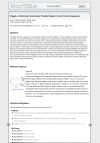BioLit: integrating biological literature with databases
- PMID: 18515836
- PMCID: PMC2447735
- DOI: 10.1093/nar/gkn317
BioLit: integrating biological literature with databases
Abstract
BioLit is a web server which provides metadata describing the semantic content of all open access, peer-reviewed articles which describe research from the major life sciences literature archive, PubMed Central. Specifically, these metadata include database identifiers and ontology terms found within the full text of the article. BioLit delivers these metadata in the form of XML-based article files and as a custom web-based article viewer that provides context-specific functionality to the metadata. This resource aims to integrate the traditional scientific publication directly into existing biological databases, thus obviating the need for a user to search in multiple locations for information relating to a specific item of interest, for example published experimental results associated with a particular biological database entry. As an example of a possible use of BioLit, we also present an instance of the Protein Data Bank fully integrated with BioLit data. We expect that the community of life scientists in general will be the primary end-users of the web-based viewer, while biocurators will make use of the metadata-containing XML files and the BioLit database of article data. BioLit is available at http://biolit.ucsd.edu.
Figures


References
-
- Fink L, Bourne P. Reinventing scholarly communication for the electronic age. CTWatch Quarterly. 2007;3:26–31.
Publication types
MeSH terms
LinkOut - more resources
Full Text Sources
Research Materials

